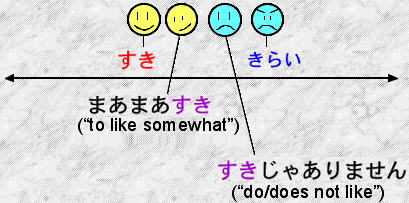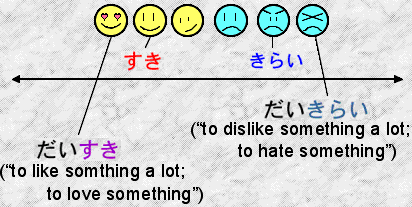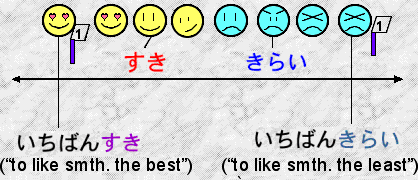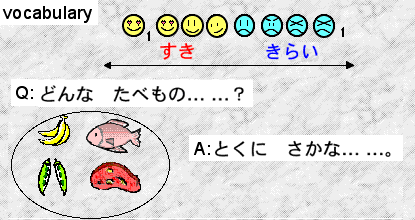 |
To talk about what you like or dislike, we use な-adjectives すき or きらい. すき means "to like" and きらい means "to dislike." Okay, you say these are verbs in English. You are right. Lesson #1: What you say using verbs in English may come out as adjectives in Japanese. Let's hear a sentence meaning "Do you like the study of Japanese?" |
| にほんごの べんきょうが すきですか。 |
 |
The first thing you say is the object of what you like (or dislike). In the example sentence you just heard, the object of what you like is にほんごの べんきょう (the study of Japanese).
|
 |
We will now try to connect the object of what you like with the すき adjective. Remember the structure for な-adjective sentence? It is this. Subject が + な-Adjective です So we put the subject marker が after what you like. (が can be the topic marker は if にほんごの べんきょう has been already said before and has become the topic.)
And then we put すきです after it.
Finally, let's make it into a question.
Now you said it using an adjective instead of a verb. |
 |
If you prefer to obtain grammatical equivalency of すきです in English, it can be translated as "is likable" although it is not commonly used in English. にほんごの べんきょうが すきです。 Or, the following adjective ("be fond of") may make more sense to some. にほんごの べんきょうが すきです。 |
Now, we are ready to respond to this question にほんごの べんきょうが すきですか. To answer "Yes, I do," you say this.
You cannot say はい、そうです here because すきです is an adjectival sentence, not a noun sentence. (I hope you still remember this rule.) |
To answer "No, I don't," you say this.
|
|||
To answer more emphatically "No, I dislike/hate it," you could say this.
But きらい is such a strong word in Japanese, so we want to say it more gently like "I don't like it very much." This requires us to express a range of liking to disliking --- "I like something very much" to "I don't like like it so much," etc. |
| A. | すき and きらいare the basis of this concept. In English, they are "to like" and "to dislike."
|
|
| B. | If you like something somewhat, you say まあまあ すき . If you don't like something, you say すきじゃありません .
|
|
| C. | To emphasize your liking or disliking something, you can put the prefix だい in front of each word. だいすき means "to like something a lot or to love something," and だいきらい means "to dislike something a lot or to hate something."
|
|
| D. | Finally, when you add いちばん, which means "number one," in front of the word, すき and きらい, it means that you named something as your most favorite, or least favorite.
|
 |
Now, let's go back to the first question sentence: にほんごの べんきょうが すきですか. What was your answer? The following is the list of all the possible answers. → はい、いちばん すきです。 |
Let's suppose you are talking about your favorite food. To ask "What do you like?" in Japanese, substitute what you like with the question word なに like this:
To answer this question, you can replace なに with an item of your choice. If you like "fish," you might say this:
If you like anything, you can use なんでも ("anything"). Notice が is NOT used with なんでも.
|
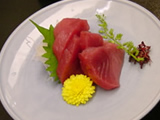 |
When you ask someone what he/she likes, normally you are discussing certain topic like food, music, sports, movies, etc. You can specify such a topic by stating a category first like this: Xは ("with regard to X"). For example, if you want to limit your question to the food category, you say this.
Another way of specifying the category is to use the question word どんな ("what kind of") before the category name. "What kind of food?" is どんな たべもの .
|
 |
If you want to emphasize your particular likes and dislikes, you can use the word とくに ("especially") as in とくに おさしみが すきです.
*お in front of さしみ is just an honorific marker to make the word more polite. |
In this presentation, we have learned various expressions for likes and dislikes. In the rest of this lesson, you will learn how to use these expressions in a conversation.
|

